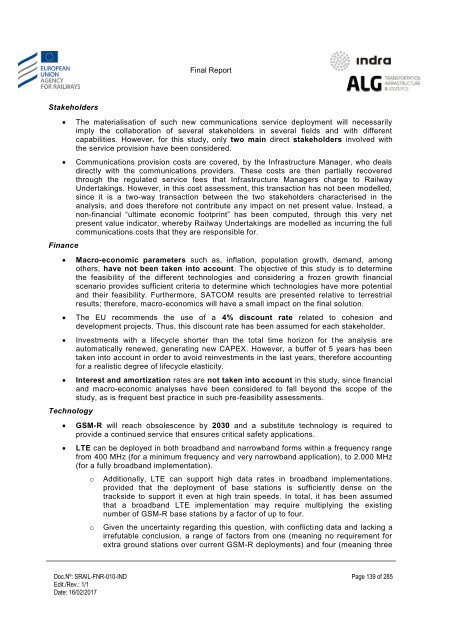Study on feasibility of SATCOM for railway communication
SRAIL-FNR-010-IND%20-%20FinalReport_v1.1_20170216
SRAIL-FNR-010-IND%20-%20FinalReport_v1.1_20170216
Create successful ePaper yourself
Turn your PDF publications into a flip-book with our unique Google optimized e-Paper software.
Final Report<br />
Stakeholders<br />
<br />
<br />
Finance<br />
<br />
<br />
<br />
<br />
Technology<br />
<br />
<br />
The materialisati<strong>on</strong> <strong>of</strong> such new communicati<strong>on</strong>s service deployment will necessarily<br />
imply the collaborati<strong>on</strong> <strong>of</strong> several stakeholders in several fields and with different<br />
capabilities. However, <strong>for</strong> this study, <strong>on</strong>ly two main direct stakeholders involved with<br />
the service provisi<strong>on</strong> have been c<strong>on</strong>sidered.<br />
Communicati<strong>on</strong>s provisi<strong>on</strong> costs are covered, by the Infrastructure Manager, who deals<br />
directly with the communicati<strong>on</strong>s providers. These costs are then partially recovered<br />
through the regulated service fees that Infrastructure Managers charge to Railway<br />
Undertakings. However, in this cost assessment, this transacti<strong>on</strong> has not been modelled,<br />
since it is a two-way transacti<strong>on</strong> between the two stakeholders characterised in the<br />
analysis, and does there<strong>for</strong>e not c<strong>on</strong>tribute any impact <strong>on</strong> net present value. Instead, a<br />
n<strong>on</strong>-financial ―ultimate ec<strong>on</strong>omic footprint‖ has been computed, through this very net<br />
present value indicator, whereby Railway Undertakings are modelled as incurring the full<br />
communicati<strong>on</strong>s costs that they are resp<strong>on</strong>sible <strong>for</strong>.<br />
Macro-ec<strong>on</strong>omic parameters such as, inflati<strong>on</strong>, populati<strong>on</strong> growth, demand, am<strong>on</strong>g<br />
others, have not been taken into account. The objective <strong>of</strong> this study is to determine<br />
the <strong>feasibility</strong> <strong>of</strong> the different technologies and c<strong>on</strong>sidering a frozen growth financial<br />
scenario provides sufficient criteria to determine which technologies have more potential<br />
and their <strong>feasibility</strong>. Furthermore, <strong>SATCOM</strong> results are presented relative to terrestrial<br />
results; there<strong>for</strong>e, macro-ec<strong>on</strong>omics will have a small impact <strong>on</strong> the final soluti<strong>on</strong>.<br />
The EU recommends the use <strong>of</strong> a 4% discount rate related to cohesi<strong>on</strong> and<br />
development projects. Thus, this discount rate has been assumed <strong>for</strong> each stakeholder.<br />
Investments with a lifecycle shorter than the total time horiz<strong>on</strong> <strong>for</strong> the analysis are<br />
automatically renewed, generating new CAPEX. However, a buffer <strong>of</strong> 5 years has been<br />
taken into account in order to avoid reinvestments in the last years, there<strong>for</strong>e accounting<br />
<strong>for</strong> a realistic degree <strong>of</strong> lifecycle elasticity.<br />
Interest and amortizati<strong>on</strong> rates are not taken into account in this study, since financial<br />
and macro-ec<strong>on</strong>omic analyses have been c<strong>on</strong>sidered to fall bey<strong>on</strong>d the scope <strong>of</strong> the<br />
study, as is frequent best practice in such pre-<strong>feasibility</strong> assessments.<br />
GSM-R will reach obsolescence by 2030 and a substitute technology is required to<br />
provide a c<strong>on</strong>tinued service that ensures critical safety applicati<strong>on</strong>s.<br />
LTE can be deployed in both broadband and narrowband <strong>for</strong>ms within a frequency range<br />
from 400 MHz (<strong>for</strong> a minimum frequency and very narrowband applicati<strong>on</strong>), to 2.000 MHz<br />
(<strong>for</strong> a fully broadband implementati<strong>on</strong>).<br />
o<br />
o<br />
Additi<strong>on</strong>ally, LTE can support high data rates in broadband implementati<strong>on</strong>s,<br />
provided that the deployment <strong>of</strong> base stati<strong>on</strong>s is sufficiently dense <strong>on</strong> the<br />
trackside to support it even at high train speeds. In total, it has been assumed<br />
that a broadband LTE implementati<strong>on</strong> may require multiplying the existing<br />
number <strong>of</strong> GSM-R base stati<strong>on</strong>s by a factor <strong>of</strong> up to four.<br />
Given the uncertainty regarding this questi<strong>on</strong>, with c<strong>on</strong>flicting data and lacking a<br />
irrefutable c<strong>on</strong>clusi<strong>on</strong>, a range <strong>of</strong> factors from <strong>on</strong>e (meaning no requirement <strong>for</strong><br />
extra ground stati<strong>on</strong>s over current GSM-R deployments) and four (meaning three<br />
Doc.Nº: SRAIL-FNR-010-IND<br />
Edit./Rev.: 1/1<br />
Date: 16/02/2017<br />
Page 139 <strong>of</strong> 285


